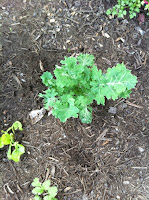Saturday, January 19, 2013
I know it seems spring is far, far away in January. Luckily for us gardeners we get to start spring early! End of January into February is seed starting time indoors.
Lowes already has Burpee seeds (organic and heirloom, too) and seed starting supplies in their stores.
So, what seeds can you start indoors at the end of this month? The cold season crops:
 Arugula
Arugula
Broccoli
Cabbage
Celery
Fennel
Leek
Lettuce
Marjoram
Mizuna
Onions
Parsley
Peas
Summer savory
Sorrel
Spinach
March is when you start your warm season crops like basil, tomatoes, peppers, eggplants, squash, and beans.
You can also start perennial flowers indoors as well. For any plant, look at the seed packet for when to plant according to your frost date. Then back up the time from there on when to start indoors. Typical seed starting is 6-8 weeks prior to the plant out date.
Here is a link to frost dates:
You can change the settings to how lucky you are feeling. Choosing 50% would be the average date of the last frost. Changing it to 30% chance means there is only a 30% chance, on average, you will get another frost.
What are the tricks to successful seed starting? The most sure fire I have found with a gadget is the Aerogarden with the seed starting tray. I have almost 100% germination rate with it.
You can also start seeds in pots you make yourself with newspaper, toilet paper cores, paper towel cores, or paper cups and sterile, organic seed starting mix. A nifty way to do it is to cut used paper towel cores into sections and line with old newspaper. You can plant the whole thing or push out the newspaper insert and compost the core.
There are also the peat pellets and peat pots. Peat is not a renewable resource, but there are substitutes for it now on the market. Just read the labels. I just bought ones made with coir at Lowes.
The key is using sterile seed starting mix, pots and containers. You can make your own seed starting mix with peat moss or coir (renewable), compost, and vermiculite. Just be sure to heat the compost to at least 150 degrees to kill any pathogens before using to start seeds.
Place the seeds in the starter mix in the pots and allow to wet thoroughly from the bottom (watering from the top can dislodge seeds). After fully saturated, they are ready to put in a catch pan. Make sure any catch pan that you use has been thoroughly washed in a bleach solution so all pathogens are killed. The one I just bought has a water reservoir in the bottom of it that wicks the moisture up under the seedlings.
I put my seed starts in a plastic tray with a clear plastic lid in a sunny window that I have had for years that you can buy at any big box store. Keep moist, but not wet, and with the clear cover on until seedling emerges. Once seedling emerges, remove the clear lid.
Make sure you label your seedlings as soon as you plant them; you may think you will remember 2 months from now what was where, but likely not. Now is also a great time to start keeping a journal. Start tracking what you planted when so you can review next year what worked well to repeat and what didn’t work so well to tweak.
Your seedling’s first leaves are not “true” leaves, think of them as baby teeth. The second set of leaves are their true leaves. They are ready to be hardened off when they have their first set of true leaves. Seedlings must be hardened and not just thrown outside. You take them out a little at a time, gradually increasing their exposure to sun and cold, only during the daytime. I try and plant when there is a warm spell forecasted to minimize the shock.
There are great selections of herbs and veggies at nurseries and big box stores nowadays so you have great options just waiting until spring is officially here and picking up what looks good at your nearby store in a couple of months. This is also a great back up if your first seed starting adventure goes a little awry...........








